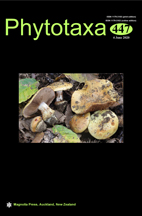Abstract
A survey of lignicolous terrestrial ascomycetes conducted in Thailand yielded a number of novel species. In this paper, we report on a terrestrial collection of a taxon from dead branches of an unidentified plant. Triseptata gen. et sp. nov. is characterized by immersed, uni- to multi-loculate ascomata, filamentous pseudoparaphyses, bitunicate, fissitunicate, cylindrical-clavate asci and 3-septate, light brown spores, with asymmetrical ends, in its sexual form. In culture, it produced hyphomycetous, globose to subglobose, multi-septate and darkly pigmented conidia-like structures. Phylogenetic analysis of a combined LSU, ITS and SSU dataset shows Triseptata to be a well-separated lineage from all genera in Latoruaceae. Based on multigene phylogeny, Triseptata gen. nov. is introduced to accommodate a single new species Triseptata sexualis and placed in Latoruaceae. Illustrations, descriptions and notes are provided for the new genus and species.

